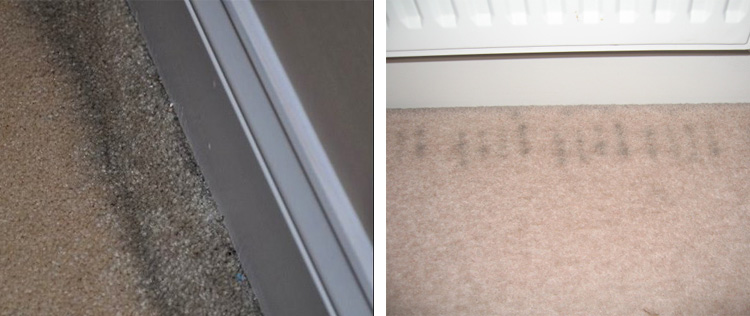
Filtration soil is a term used to describe dark, grayish lines that may appear on carpet. This is not a carpet defect, but a situation in which dust and other airborne pollutants can accumulate on the carpet face fibers in areas with a concentrated flow of air over the carpet or through tiny cracks or other open areas under the carpet. The soiling condition can occur quickly, or it may develop over a period of months or years. The level of soiling is dependent upon the volume of airflow and the level of pollutants in the air. Filtration soiling is not a result of the quality of carpet selected. The condition will obviously appear more pronounced on lighter colourations than darker colourations.Filtration soil areas may appear around skirting boards, under doors, along the edges of stairs and possibly away from walls where wooden sub flooring materials have been joined,and where floorboards have been removed and replaced.
Generally, the concentrated air flow will be from an upper level to a lower level of the home.As indicated, filtration soiling can occur under closed interior doors .Filtration soil may be fireplace or automobile emissions, residue from furniture polishes, fine sand or clay particles, cooking oils, or a host of other soils or a combination of soils. Oily airborne contaminants trapped by carpet fibers will serve to attract more dry soil. It is difficult to identify effective methods to reduce or prevent filtration soiling. Preventing airflow through carpet and carpet edges by sealing cracks in the subfloor, as well as under skirting boards and edges of stairs, may reduce filtration soiling problems. Keeping air inside the home as clean as possible can be accomplished by reducing indoor air pollutants, such as cooking emissions, fireplace smoke, burning candles, cigarette smoke, and emissions from cleaning chemicals.
While no one cleaning technique may be successful in all filtration soiling situations, recent innovations in soil- and stain-resist treatments applied to carpet have reduced the effort previously needed to remove the filtration soil. However, the complete removal of contaminants from the soiled areas can be complicated, depending on the type of contaminant materials present. To achieve the best results, the services of a cleaning professional should be considered.
